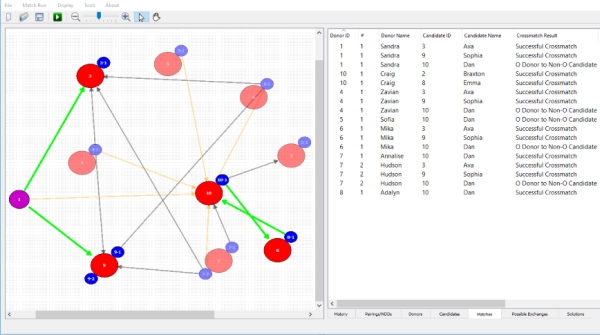Interactive Software for Simulation and Management of a Kidney Paired Donation Program
1University of Michigan, Ann Arbor, MI
2Alliance for Paired Donation, Maumee, OH
3Arbor Research, Ann Arbor, MI.
Meeting: 2018 American Transplant Congress
Abstract number: A157
Keywords: Allocation, Donation, Kidney transplantation
Session Information
Session Name: Poster Session A: Kidney Paired Exchange
Session Type: Poster Session
Date: Saturday, June 2, 2018
Session Time: 5:30pm-7:30pm
 Presentation Time: 5:30pm-7:30pm
Presentation Time: 5:30pm-7:30pm
Location: Hall 4EF
In kidney paired donation (KPD), candidates with willing but incompatible donors are pooled together with the goal of finding new transplant opportunities by exchanging donors. Transplants occur via exchange cycles, where the donor from one pair donates to the candidate in the next pair along the cycle, or via transplant chains originating from non-directed donors (NDD). The goal is to maximize the number of transplants, or, by assigning a score to each potential transplant reflecting certain clinical factors, to maximize the total score.
Objective criteria are used to determine the optimal choice of exchanges, which cannot typically be found by simple inspection. However, the consequences, positive or negative, of selecting one set of exchanges over another may not be immediately apparent to clinicians.
We develop a software platform that gives the user control of a virtual KPD pool in an interactive environment. We display the pool as a graphical network with pairs and NDDs represented as nodes and potential transplants represented by arrows connecting the donor and candidate. We include implementation of different optimization criteria, accounting for probabilities of exchange failure (between selection and transplantation) and fallback options in the case of such failure, based on previous research by our group (Bray et al, AJT 2015). The platform allows users to compare optimal solutions under different criteria and scoring assignments. New features in development include support for multiple associated donors for each candidate.
Figure 1 displays a virtual KPD pool in our platform. Pairs are represented by red nodes denoting the candidate, surrounded by blue nodes representing their paired donors. Purple nodes represent NDDs. An arrow represents a match between the donor at the origin and the candidate at the destination. Arrow coloring is used to highlight certain match qualities to be aware of, in this case a blood type O donation to a blood type O candidate. A valid KPD solution is highlighted in green.
CITATION INFORMATION: Bray M., Wang W., Rees M., Song P., Leichtman A., Ashby V., Kalbfleisch J. Interactive Software for Simulation and Management of a Kidney Paired Donation Program Am J Transplant. 2017;17 (suppl 3).
To cite this abstract in AMA style:
Bray M, Wang W, Rees M, Song P, Leichtman A, Ashby V, Kalbfleisch J. Interactive Software for Simulation and Management of a Kidney Paired Donation Program [abstract]. https://atcmeetingabstracts.com/abstract/interactive-software-for-simulation-and-management-of-a-kidney-paired-donation-program/. Accessed December 26, 2025.« Back to 2018 American Transplant Congress

